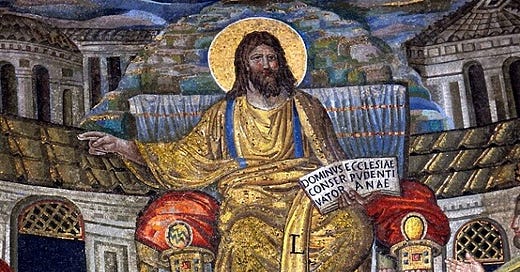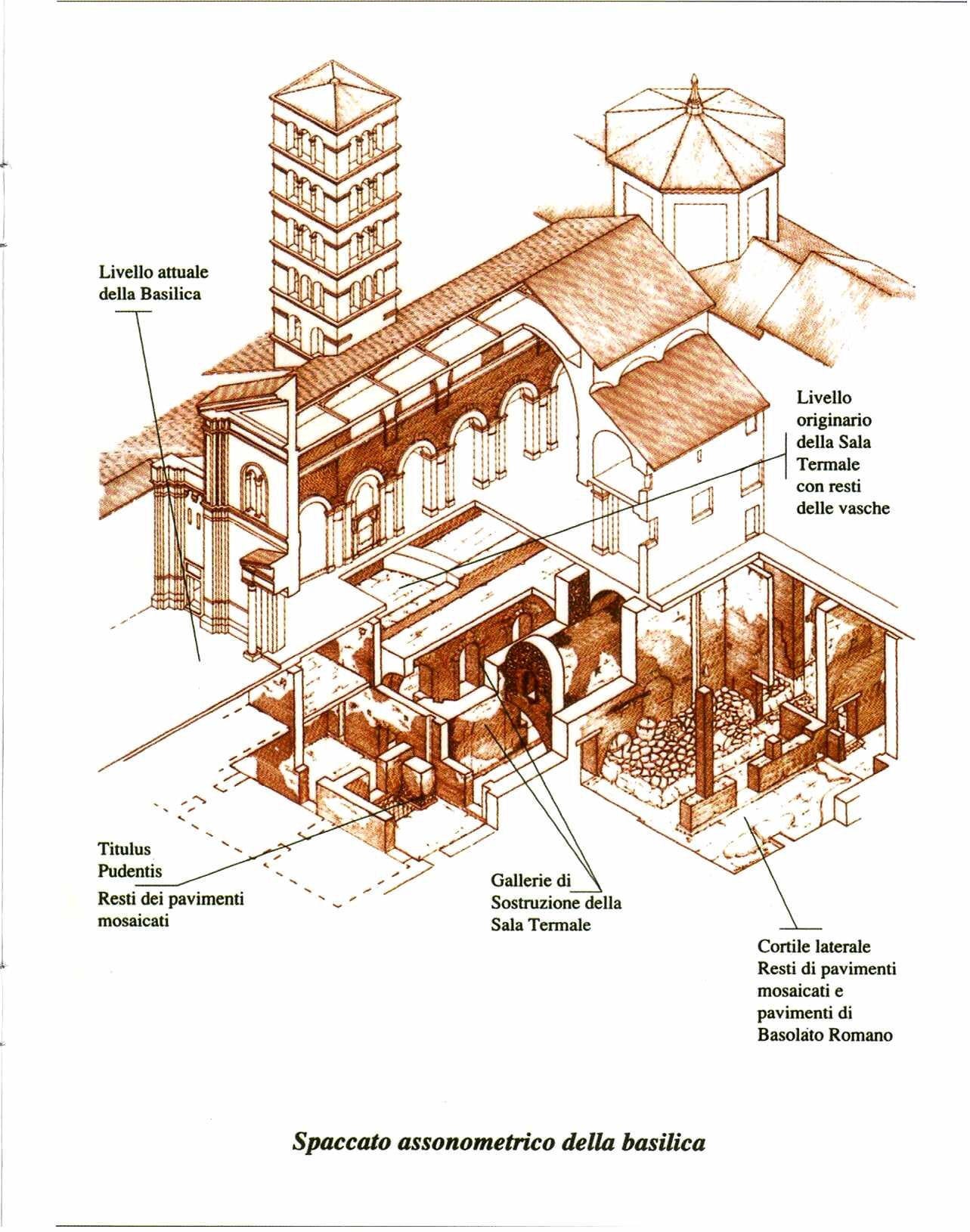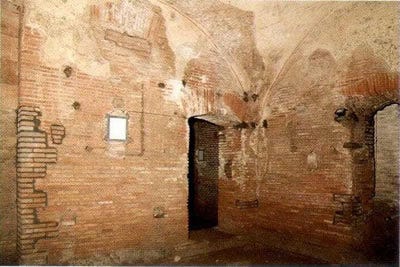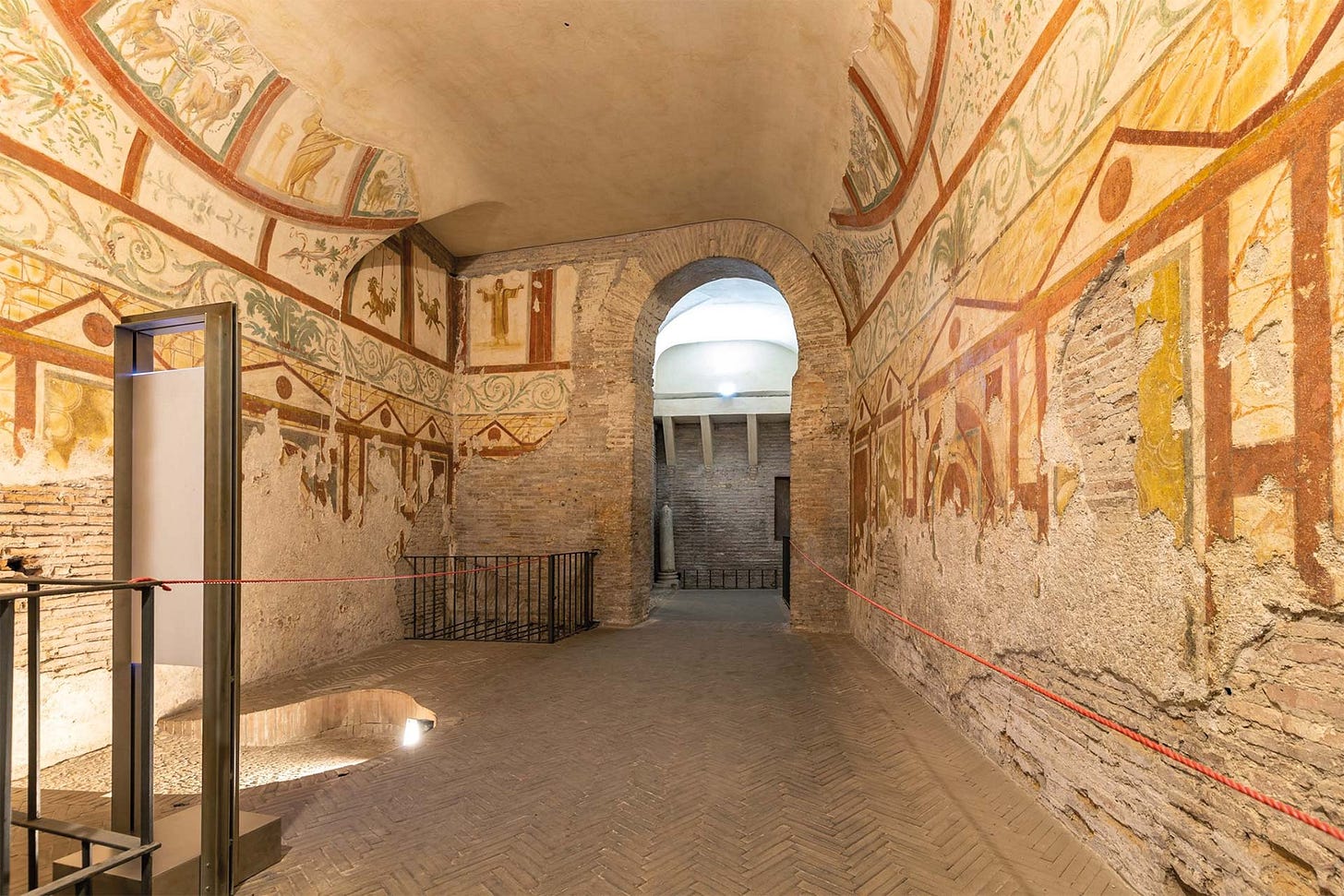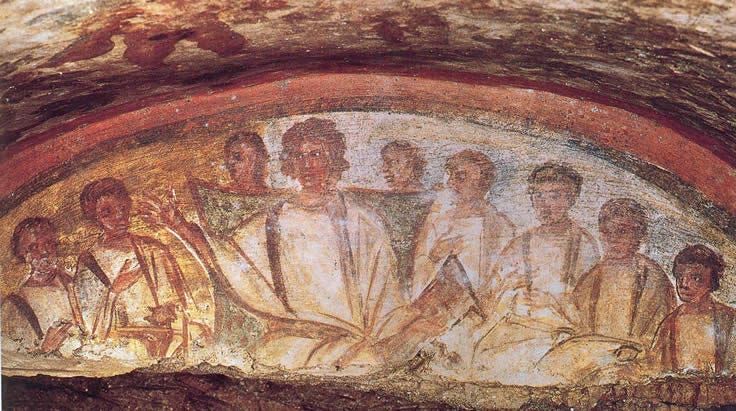Santa Pudenziana; ancient Roman house churches you can visit
Below the fold: an early Christian theology of sacred space
Domus Ecclesiae - what was a house church really like?
When we think of early Christianity in Rome, we often imagine the catacombs or the majestic basilicas that rose after the faith was made legal. We speak commonly of the early Church under persecution as the “Church of the Catacombs”. But many of the earliest places of worship were ordinary houses repurposed into sacred spaces.
These sites remind us that Christianity began not in monumental structures, either physical or intangible, but in the intimacy of shared meals, whispered prayers, and communal faith.
I thought with the Jubilee Year opening this month, and the chances pretty good that at least some of you might be going to Rome, we could look at some of the house churches that still exist in the city where visitors can still go.
The Domus Ecclesiae of Santa Pudenziana - the oldest church in Rome?
Santa Pudenziana is a 4th century Roman basilica that is one of the oldest churches in the city. It was an ancient thermal bath of the 2nd century built over and in the ruins of the house of the senator Pudens.
Pudens is mentioned in 2 Timothy 4:21 and is traditionally believed to have hosted St. Peter and St. Paul in his home during their missions in Rome. He was converted by the apostle Peter, who lived in his friend’s home for seven years.
It is believed that Rome’s early Christians gathered here during the first century for worship and fellowship, making it one of the earliest locations associated with Christianity in Rome.
After the house fell out of use, a thermal bath complex was constructed on the site, a common practice in urban Rome as the city developed and expanded. The original house was incorporated into the bath structure.
In the mid-2nd century, about 154, the site became a Domus Ecclesiae with the “Titulus Pastoris” designation, possibly repurposing parts of the former bath complex or utilizing the site’s existing structures. This marked its transition into a space for Christian worship, which remained modest and private due to periodic state persecutions.
After Christianity was legalized with Constantine’s Edict of Milan (313 AD), the house church was further transformed into a full-fledged basilica, completed about 380-390, a public and monumental place of worship that remains today. The site became associated with St. Pudentiana and her sister St. Praxedes, Pudens’ daughters.
According to tradition, Pudentiana lived a life of prayer, charity, and service to the early Christian community in Rome. After her father’s death, she is said to have dedicated herself to distributing the family’s wealth to the poor and helping persecuted Christians.
Here’s the website where you can book a tour. Tickets are €10, and you need to make a reservation to visit.
What’s a “Titulus Pastoris”?
In early Christianity, a “titulus” was the name given to a house church or gathering place formally associated with a community of believers. These sites were often named after donors, significant members of the community, or saints connected to their history. Over time, “tituli” became the foundational parishes of the Christian Church in Rome. After Constantine legalized Christianity in AD 313, these house churches were integrated into the official structure of the Church.
If there were any doubts about the formal administrative reality of the early Roman Church, the sixth-century chronicler of the Liber Pontificalis states that Cletus, on the order of St Peter himself, ordained twenty-five priests to whom, at the beginning of the century, were entrusted the parish churches or tituli of Rome.
Today, when a cardinal is appointed, he is assigned a titular church. This is largely symbolic and reflects the cardinal’s historical role as part of the clergy of the Diocese of Rome, under the pope as the bishop of Rome.
The status of Titulus Pastoris for Santa Pudenziana, which is still considered a titular parish church, dates to AD 154, making it one of the oldest parishes in Rome.
Other House Churches in the city
San Clemente al Laterano - a layer cake of Roman history, that chronicles the city’s transition from official paganism to official Christianity. Remnants of Roman houses (500-27 BCE) have been found 20 metres below this church, that are thought to have been among those destroyed by a large fire during the reign of emperor Nero. On top of these foundations, another large house was found that had been built in the 1st century. This house served as a secret church for pope St. Clement. Also under the basilica is a Mithraic temple, which can still be seen.
The 4th-century church is one of the earliest examples of a domus ecclesiae, where Christians gathered for worship before the legalization of Christianity. Over time, the site was expanded into a full basilica after the Edict of Milan.
Basilica of Santi Giovanni e Paolo on the Caelian Hill
The basilica is built over the home of two Roman soldiers, John (Giovanni) and Paul (Paolo), who were martyred for their Christian faith during the reign of Emperor Julian the Apostate in the 4th century.
Their house became a Domus Ecclesiae after their deaths, a place where Christians gathered to venerate the martyrs and celebrate the Eucharist.
Beneath the current basilica, excavations have revealed the ancient Roman house where John and Paul lived and were executed. The house features Christian frescoes, including some of the earliest depictions of Christ and Christian symbols, making it a treasure trove for early Christian art and worship practices.
The hypogeum (underground level) also includes a small chapel used by early Christians, further highlighting the site’s history as a place of secret worship during times of persecution.
In the late 4th century, the site was transformed into a basilica by Senator Pammachius, a wealthy Christian and supporter of the Church. This marked its transition from a private home to a public place of Christian worship.
Here’s where you can book a tour. (NB: photos officially not allowed, but you can usually negotiate.)
Domitilla Catacombs and Chapel
The Domitilla Catacombs, named after Flavia Domitilla, granddaughter of the emperor Vespasian who was first exiled and then burned to death for her Christian faith. These catacombs are among the oldest and largest in Rome, stretching over 15 kilometres and containing thousands of burial niches. Dating to the 2nd century, they served as both a burial site and a place of worship during times of persecution.
Within the catacombs lies a small underground chapel, used as a house church for celebrating the Eucharist and honouring martyrs like Saints Nereus and Achilleus. The chapel features some of the oldest Christian frescoes, depicting symbols like the Good Shepherd, fish, and anchor.
You can see the opening times and book a tour here.
At the Sacred Images Project we talk about Christian life, thought, history and culture through the lens of the first 1200 years of sacred art. The publication is how I make my living, supported by subscriptions, so apart from plugging my shop, there is no advertising or pop-ups. It’s my full time job, but it’s still not bringing a full time income, so I can’t yet provide all the things I want to and am planning for.
You can subscribe for free to get one and a half posts a week.
For $9/month you also get the second half of the third post, plus a weekly paywalled in-depth article on our great sacred patrimony. There are also occasional extras like downloadable exclusive high resolution printable images, ebooks, mini-courses, videos and eventually podcasts.
Subscribe to join us below the fold, for more discussion of medieval books, and what they meant to the building of an empire and a civilisation. We’ve got some beautiful high resolution images from some manuscripts of this period.

